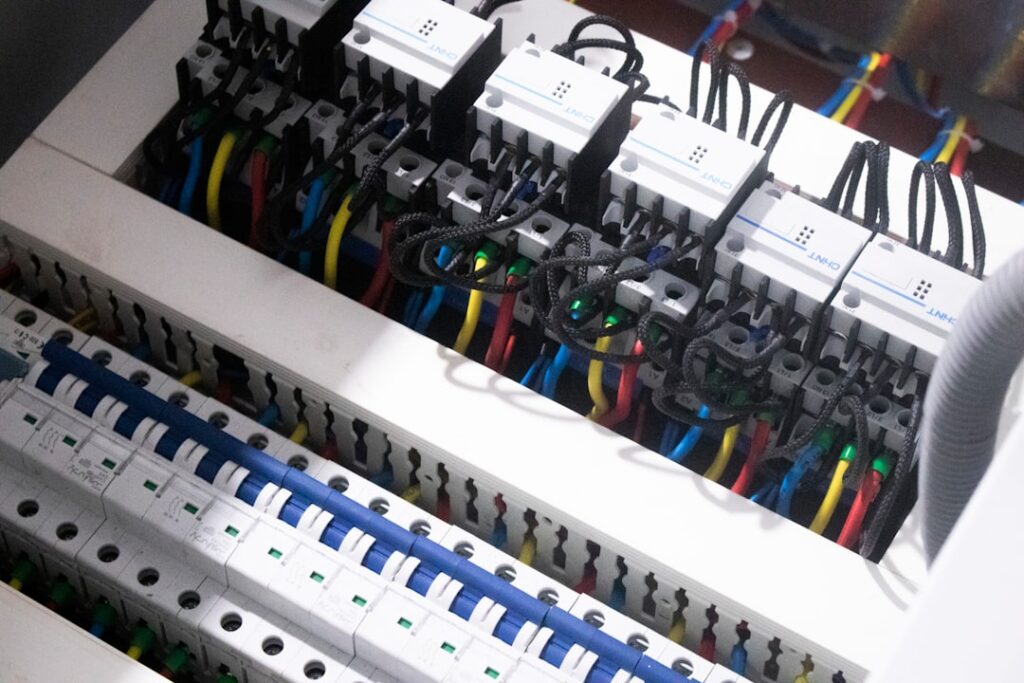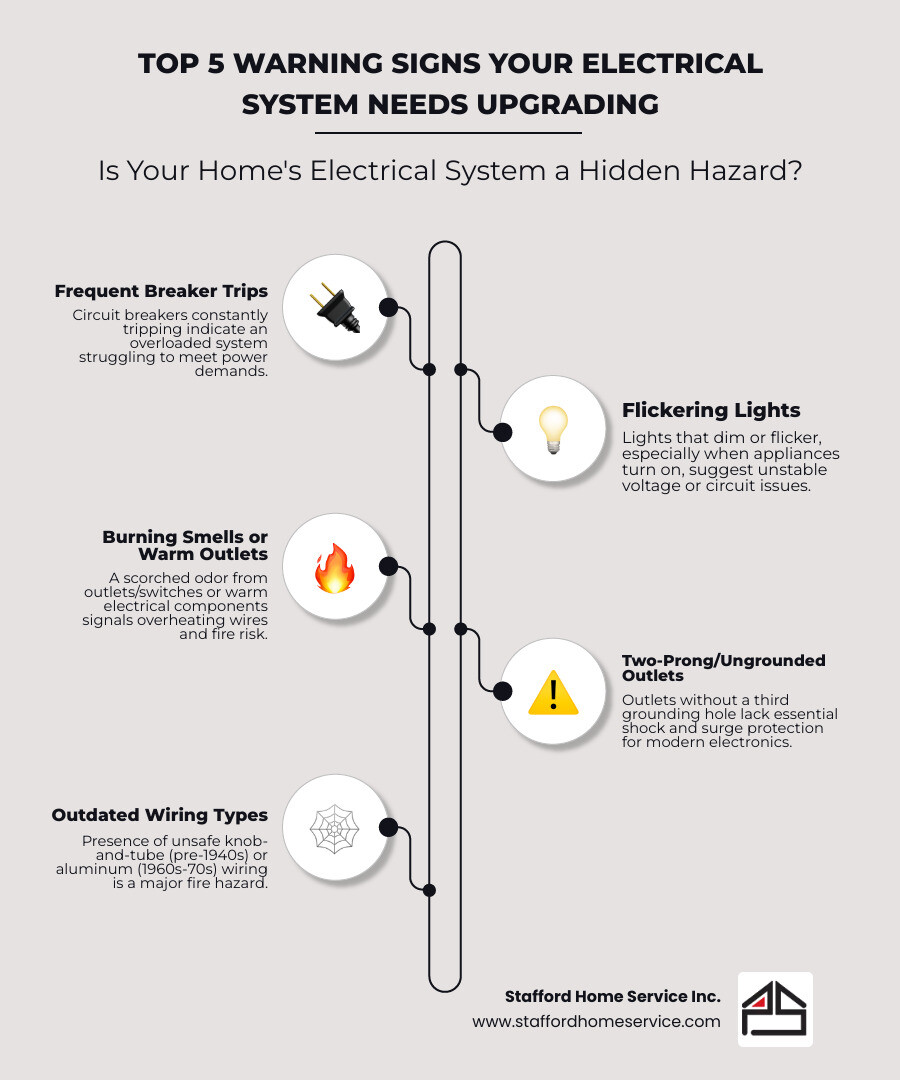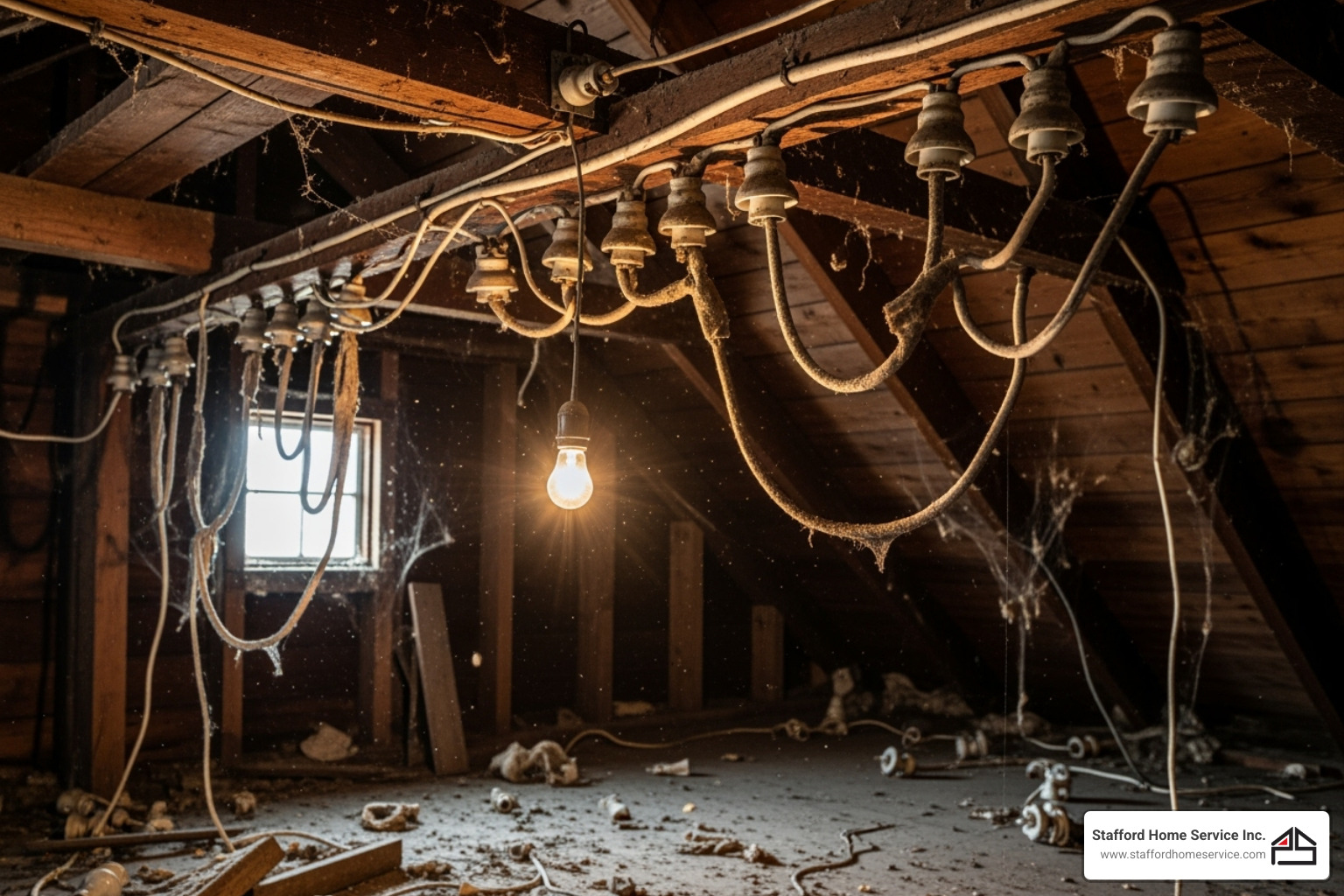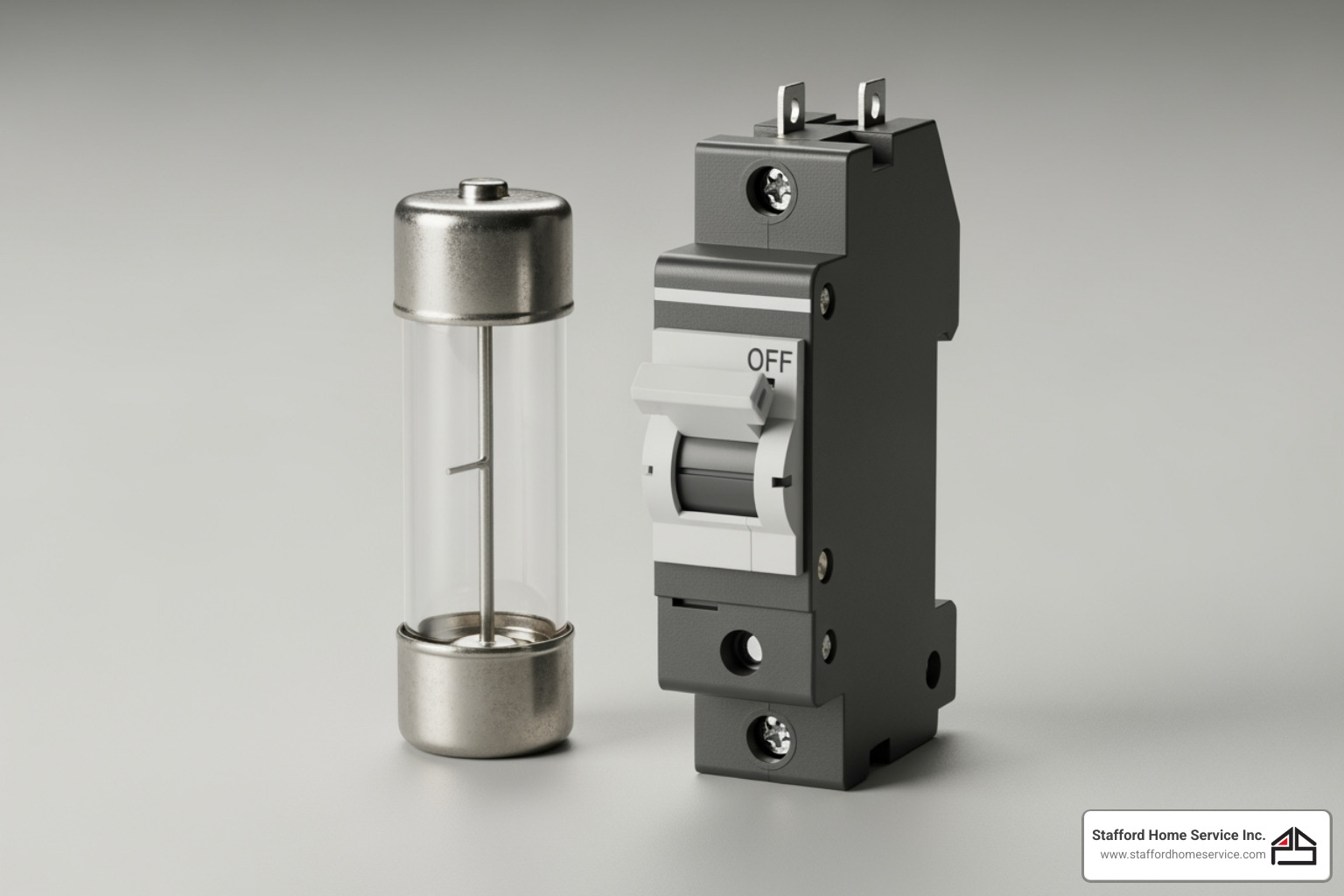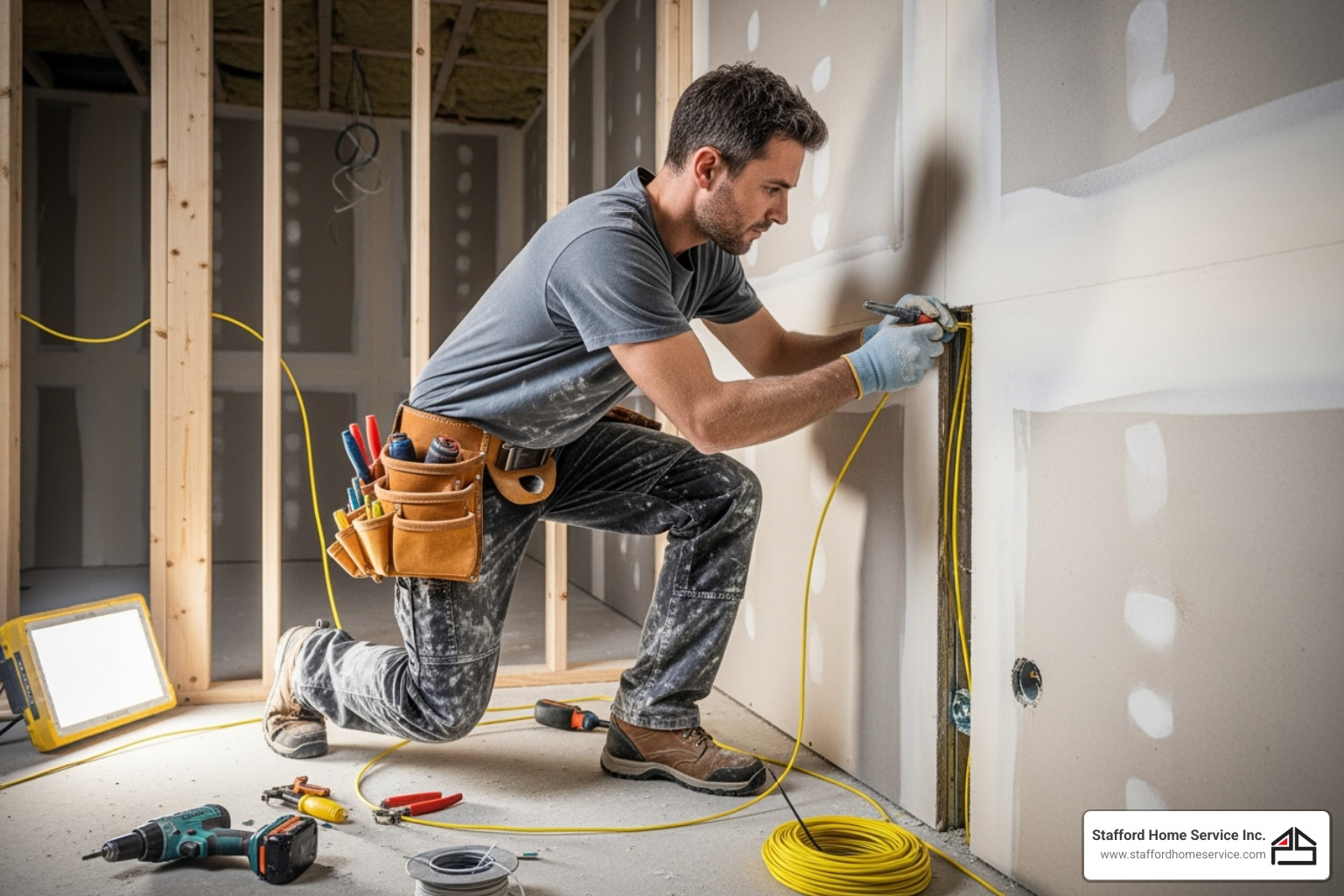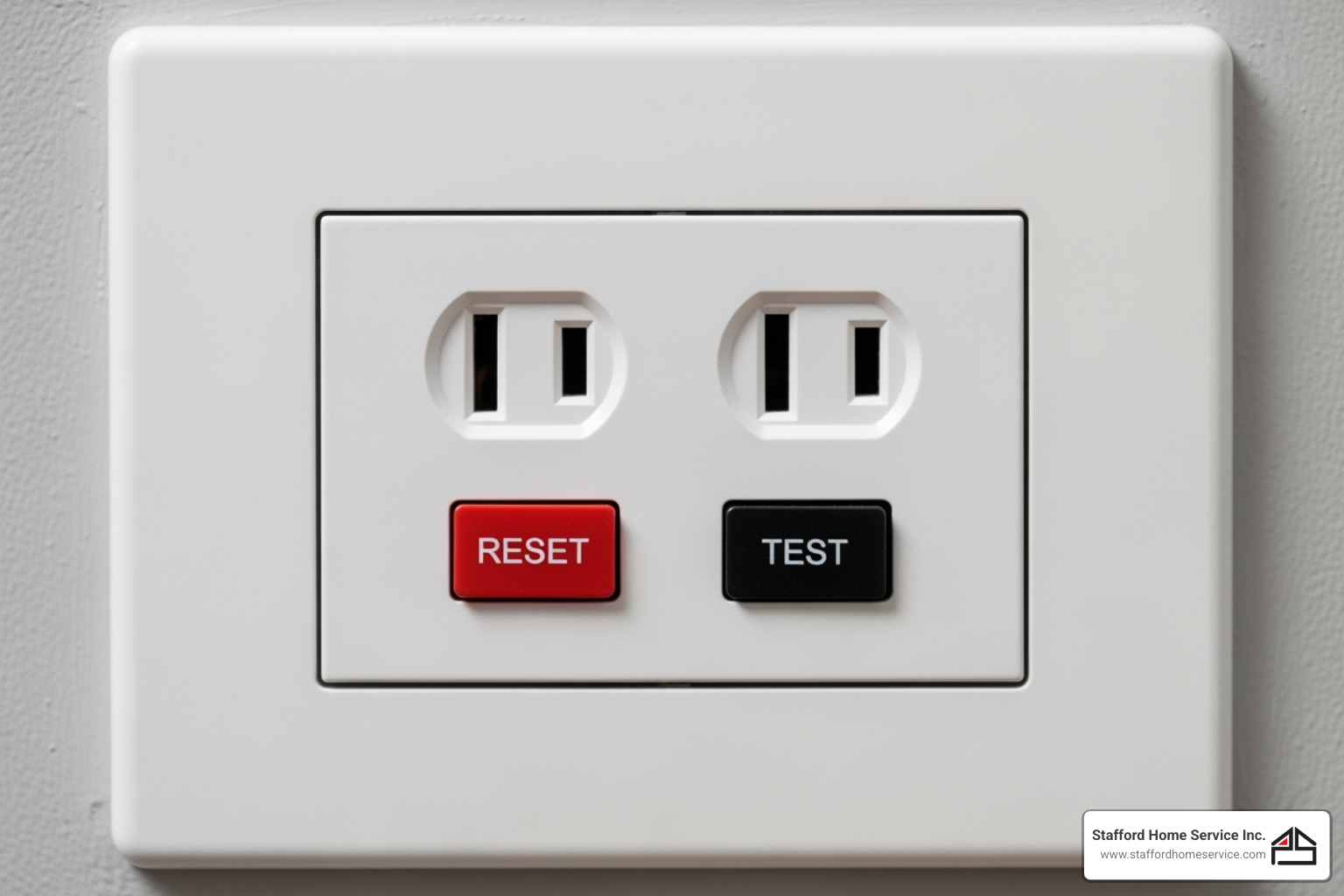Why Your Home’s Electrical System Needs Your Attention
Electrical wiring upgrades are essential safety improvements that modernize your home’s power system to handle today’s demands and prevent fire hazards. Upgrading your electrical system protects your family and property, whether you’re dealing with flickering lights, tripping breakers, or outdated wiring.
Key reasons to upgrade your electrical wiring:
- Safety first – Faulty wiring causes approximately 51,000 home fires annually, resulting in around 500 deaths
- Increased capacity – Modern homes need 200 amps vs. the old standard of 60 amps
- Code compliance – Bring outdated systems up to current National Electrical Code standards
- Future-proofing – Support smart home technology, EV chargers, and high-power appliances
- Home value – Updated electrical systems increase property value and lower insurance costs
If your lights and appliances work, you might think your wiring is fine. Not necessarily.
Hidden in your walls, aging electrical systems often struggle with modern demands. Homes built before the 1970s may have dangerous aluminum or knob-and-tube wiring that can’t safely handle today’s electrical loads.
Your electrical system is your home’s circulatory system—a major failure can put your family at serious risk.
Is Your Home’s Electrical System a Hidden Hazard?
Your home’s electrical system works quietly, but it sends warning signs when something is wrong. Dimming or flickering lights, especially when you turn on appliances, indicate a struggling electrical system. Similarly, if you’re constantly resetting tripping breakers, your circuits are overloaded.
More serious signs demand immediate attention, like a burning smell from outlets or switches, or warm outlets that are hot to the touch. Two-prong outlets are likely ungrounded outlets, increasing the risk of electrical shock.
A sobering fact: Faulty wiring is the leading cause of residential fires, causing about 51,000 fires and 500 deaths annually. These fires often start with overloaded circuits—when an electrical system is asked to handle more power than it was designed for.
Identifying Outdated and Dangerous Wiring
Knowing what outdated wiring to look for can help you identify when it’s time for electrical wiring upgrades.
Knob and tube wiring, found in pre-1940s homes, can’t handle modern electrical loads. Its brittle cloth and rubber insulation, lack of grounding, and inefficiency create both a fire hazard and shock risk.
Aluminum wiring was common in homes built in the 1960s and 1970s. It expands and contracts more than copper, leading to loose, overheating connections that can corrode and cause fires.
Frayed insulation on any wiring exposes bare conductors, creating a fire hazard. Never handle damaged wiring yourself; it’s a job for licensed professionals.
Fuse Boxes vs. Circuit Breakers
Your electrical panel is your home’s power hub. Modern circuit breakers are a major upgrade over old fuse boxes.
Fuse box limitations are clear: fuses must be replaced when they blow, and using the wrong size is a safety hazard. This older technology can’t meet modern electrical demands.
Circuit breaker advantages are numerous. They are reusable switches that trip automatically during an overload and reset with a simple flip. They provide superior, more precise overcurrent protection and have a lifespan of components around 30-40 years, highlighting the safety differences.
The upgrade from fuses to circuit breakers isn’t just about convenience—it’s about protecting your home with modern technology.
The Powerful Benefits of Modern Electrical Wiring Upgrades
Electrical wiring upgrades are an investment in your home’s safety, efficiency, and future-readiness. A modern electrical system can significantly increase your home value, as buyers are wary of inheriting electrical problems. Many insurers also offer lower insurance premiums for updated homes, knowing they have a lower risk of electrical fires.
Beyond finances, you’ll see improved energy efficiency. Old wiring is inefficient, wasting energy as heat. Modern copper wiring conducts electricity better, reducing waste and helping appliances run smoothly. You’ll also enjoy better system reliability. An upgraded system handles your daily electrical needs without tripping breakers or causing lights to dim. Most importantly, upgrading is about future-proofing your home for our increasingly electric world.
Enhancing Safety and Peace of Mind
Electrical wiring upgrades are fundamentally about protecting your family. Fire prevention is a top benefit, as upgrades eliminate dangerous old wires, loose connections, and overloaded circuits.
Shock prevention is also crucial. Modern grounded outlets and safety devices like Ground Fault Circuit Interrupters (GFCIs) provide layers of protection. GFCI protection detects dangerous current paths and shuts off power in milliseconds, and is essential in kitchens, bathrooms, and garages.
AFCI protection from Arc Fault Circuit Interrupters adds another safety layer by detecting dangerous electrical arcs from damaged wires, cutting power before a fire can start.
Every upgrade ensures full code compliance with the National Electrical Code, which incorporates decades of safety knowledge. For families with children, tamper-resistant receptacles have built-in shutters to prevent objects from being inserted into outlets.
Meeting Today’s (and Tomorrow’s) Power Demands
Today’s homes are packed with power-hungry devices, far beyond the simple needs of the past.
| Feature | Old 60-Amp Service (Typical Pre-1970s) | Modern 200-Amp Service (Current Standard) |
|---|---|---|
| Typical Appliances | Basic lights, refrigerator, small TV | Multiple TVs, computers, AC, electric dryer, EV charger, smart home devices |
| Circuit Capacity | Limited, prone to overloads | Ample, supports multiple high-draw appliances simultaneously |
| Safety Features | Fuses, ungrounded outlets | Circuit breakers, GFCI/AFCI protection, grounded outlets |
| Expansion Capability | Very limited | High capacity for future additions |
Upgrading from 60 amps to the modern 200-amp standard provides a massive increased capacity. This supports home offices, high-power appliances like induction cooktops, and modern HVAC systems.
Growing smart home technology—from thermostats to security systems—requires reliable power. EV charging stations require a dedicated 240-volt circuit that many older electrical panels can’t handle without an upgrade.
Consider adding structured wiring (high-quality data cables) during an electrical upgrade. This creates a backbone for fast internet and reliable smart home and entertainment systems. Most modern homes need at least 200 amps to handle today’s electrical demands comfortably.
The Upgrade Blueprint: What the Process Involves
With experienced professionals, the electrical wiring upgrades process is more straightforward than you might think. Every upgrade begins with a comprehensive electrical system assessment. We examine your wiring, outlets, and panel to identify safety hazards, code violations, and capacity issues.
We handle all required local permitting, which ensures the work meets safety standards. Afterward, official inspections verify that the professional installation meets all code compliance standards, giving you an extra layer of protection and peace of mind.
The Scope of Work: Partial vs. Full Home Rewiring
The scope of your upgrade depends on your home’s condition, age, and your goals.
When a partial rewire is sufficient, we might focus on specific needs, like a kitchen renovation or adding an EV charger circuit. This approach is less disruptive and more budget-friendly. However, a full home rewire is often necessary for safety if you have knob-and-tube or aluminum wiring. It’s also recommended for homes with widespread issues like frequent flickering lights or tripping breakers.
While a full rewire has a higher cost comparison and disruption level, it’s a comprehensive solution that provides significant long-term safety and reliability benefits.
The Heart of the System: Your Service Panel and Breakers
Your service panel is the heart of your electrical system. A service panel upgrade is a critical part of most projects. Upgrading an old fuse box or a small-capacity panel to a modern 200-amp system—today’s standard—transforms your home’s electrical capabilities.
The size of the service panel you need depends on the size of your home. Electrical panels come in different amp sizes. For example, a 100 amp panel would not be adequate for a home with an HVAC system and multiple appliances.
The upgrade includes circuit breaker replacement with modern, reliable ones. For larger properties, a subpanel installation can efficiently distribute power to specific areas like a workshop without overloading the main panel.
Essential Safety Upgrades: GFCI, AFCI, and Surge Protection
Modern electrical safety is about having the right protection systems in place.
Ground Fault Circuit Interrupters (GFCI) are lifesavers. They detect improper current flow and shut off power instantly. We install them where water and electricity might meet, such as kitchens, bathrooms, and garages.
Arc Fault Circuit Interrupters (AFCI) prevent fires by detecting dangerous electrical arcs from damaged wires or loose connections—hazards that regular breakers might miss. We install them as breakers in the main panel to protect living areas.
Whole-house surge protection is essential for modern homes. Installed at your main panel, it protects all your electronics and appliances from damaging voltage spikes.
Decoding the Cost of Your Electrical Wiring Upgrade
The cost of electrical wiring upgrades is a primary concern for homeowners. The investment varies based on several factors. Key factors determining the cost include home size and accessibility of wiring. A larger home costs more, and wiring that is easily accessible is less expensive to replace than wiring that requires opening finished walls.
The project’s scope of work, from a simple panel upgrade to a full rewire, also significantly impacts the price. Other factors include fluctuating material costs (like copper), regional labor rates, and municipal permit fees.
Factors Influencing the Cost of Electrical Wiring Upgrades
Understanding these cost drivers helps you make informed decisions and avoid surprises.
- Drywall repair can be a major cost variable. If we must open walls to install new wiring, this adds patching and painting costs. Timing a rewire with other renovations can minimize this impact.
- The panel location affects cost. An easily accessible panel is simpler and less expensive to work on than one in a difficult location.
- The age of home can add complexity. Older homes may have had multiple, sometimes improper, modifications over the years, which requires more time to trace and correct.
- The type of wiring being replaced also influences the scope. Removing knob-and-tube or aluminum wiring requires special techniques and safety protocols that our experienced electricians are equipped to handle.
Average Costs for Common Upgrades
While every home is unique, these industry averages provide a baseline for budgeting.
A service panel upgrade is a core part of modernization. The average cost to upgrade an electric service panel is $1,800, according to Forbes. This usually includes upgrading to a 200-amp service to meet modern demands.
For extensive issues, a full house rewiring may be needed. If you notice your lights flicker or you frequently trip your circuit breaker, it might be time to rewire your house. Your house could have old, outdated wiring, which is a fire hazard. That rewiring your house will likely include taking down walls so an electrician can run new wires. The cost varies significantly with home size and complexity.
GFCI outlet installation is a modest but crucial safety upgrade. Proper installation requires expertise to ensure they function correctly.
Whole house surge protection offers excellent value, safeguarding all your electronics and appliances from power surges.
This is an investment in your family’s safety and your home’s future. Quality work from licensed professionals provides decades of reliability and peace of mind.
Frequently Asked Questions about Electrical Upgrades
Homeowners considering electrical wiring upgrades often have similar questions about safety and investment. Here are answers to the most common ones we receive.
Why is it critical to hire a licensed electrician for wiring upgrades?
Working with electricity is dangerous and requires specialized expertise. A licensed electrician has the training to ensure your safety, understanding the National Electrical Code (NEC) and local codes that exist to save lives. They also handle necessary permits, inspections, and documentation, which is crucial for your home’s value and insurance coverage. Most importantly, licensed electricians provide guaranteed, insured, high-quality workmanship. DIY or unlicensed work risks fire, shock, and could void your homeowner’s insurance.
How long does a typical full home rewiring take?
A full rewiring project typically takes from three days to two weeks. The timeline depends on your home’s size and the accessibility of the wiring. Fishing wires through walls is faster than projects that require opening and repairing drywall. We work efficiently to minimize disruption. Some families plan the project during a vacation, especially if major circuits will be temporarily offline.
Can upgrading my wiring lower my energy bills?
Yes, upgrading your wiring can lower energy bills. Modern copper wiring is more conductive and efficient than older systems. With old wiring, energy is lost as heat due to resistance, meaning you pay for electricity that never reaches your appliances. A properly sized system also prevents overloading, another energy waster. Overloaded circuits force appliances to work harder and use more electricity. A modern system ensures appliances get the steady power they need to run efficiently. Over time, the improved efficiency adds up to meaningful savings, and your appliances will likely last longer.
Conclusion: Power Your Home with Confidence
You expect your electrical system to work flawlessly, but if it’s outdated, it may be struggling to keep up with modern demands.
Electrical wiring upgrades are more than a simple fix; they create a foundation of safety and reliability for your family and home. Upgrading from dangerous knob-and-tube or aluminum wiring to modern copper with proper GFCI and AFCI protection dramatically reduces fire risks.
The benefits extend beyond safety. A modernized system powers a technology-driven lifestyle, supporting home offices, EV chargers, and multiple high-power appliances without tripping a breaker.
While the investment may seem significant, the increased home value, lower insurance premiums, improved energy efficiency, and peace of mind make it one of the smartest investments for your home.
The process isn’t overwhelming with the right professionals. At Stafford Home Service Inc., our experienced team has helped families across Minneapolis, Edina, Golden Valley, Minnetonka, Plymouth, St Louis Park, and Minnesota create safer, more efficient homes for years. We handle everything from assessment and permitting to final inspection, ensuring your upgrade meets all codes. Our commitment to quality workmanship and complete customer satisfaction means the job is done right.
Don’t wait for warning signs to become serious problems. If your home is older or showing red flags, it’s time for a professional assessment. Your family’s safety is too precious to risk.
Ready to power your home with confidence? Contact us for professional electrical services in Minneapolis. We’ll ensure your home is safe, efficient, and ready for the future.



